Chilli (Capsicum annuum L.)
Solanaceae
Solanaceae
Varieties
K 1, K 2, CO 2, CO 4 (vegetable type), PKM 1, PMK 1 (for semi-dry conditions in Southern Districts), PLR1 (for coastal regions of North - East Tamil Nadu) and KKM (Ch) 1.
K 1, K 2, CO 2, CO 4 (vegetable type), PKM 1, PMK 1 (for semi-dry conditions in Southern Districts), PLR1 (for coastal regions of North - East Tamil Nadu) and KKM (Ch) 1.
Hybrids
TNAU Chilli Hybrid CO 1
TNAU Chilli Hybrid CO 1
.jpg) |
CO.1 (1979):Reselection from Sattur samba.Eruits are long ,bright red in colour. Yields about 2.10tonnes/ha of dry pod in a crop duration of 210 days. Fruits have high capsaicin content (0.72mg/g).
| .jpg) |
CO.2 (1982):Selection from Nambiyur local ‘Gundu type’.Fruits are thick and red in colour with high seed content and pungency. Harvested for both green and red ripe pods Yields about 2.20tonnes/ha of dry pod in a crop duration of 210 days.
| |
.jpg) |
CO.3 (1991):Selection from OP type introduced from Sri Lanka.Suitable for close planting (30 x 15 cm) and less affected by heavy wind. Yields about 3.00 – 3.50 tonnes/ha of dry pod and 15-18 t/ha of green chilli in a crop duration of 165 days. Fruits have high oleoresin content (13%)
| .jpg) | CO.4 (2000):
It is a pureline selection made from an OP type introduced from Sri Lanka. Suitable for making chutney, curry and pickles, low pungency (0.29% Capsaicin
Yields about 23 tonnes/ha of green chilli in a crop duration of 165 days | |
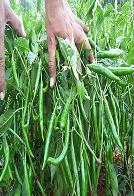 |
TNAU HYBRID CHILLI CO 1:Unripe fruits light green in colour, elongated, tapering towards the tip and 10.5 – 12.0 cm long.Capsaicin and oleoresin contents of 0.58 % and 14.0 % respectively. Moderately resistant to fruit rot disease. Yields about 6.74 t/ha of dry pod and 28.10 t/ha of green chilli in a crop duration of 195-205 days .
|  | K2It was a cross of K 1 and Sattur samba. Yields about 2.1 t of dry pods/ha in a crop duration of 210 days | |
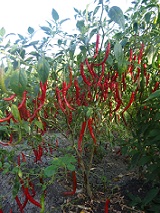 |
KI :
It is a pure line selection from an Assam type B 72 A. Plants are tall and spreading fruits are with pointed tip.Yields about 1.8 t of dry pods/ha in a crop duration of 210 days .Suitable for rainfed cultivation. | .jpg) | KKM(Ch1):
High yield – 3.03 t/ha of dry fruits with high capsaicin content (0.54%).Early maturity - first harvest 92 days after planting. Suitable for export because of non shriveling nature even after drying
| |
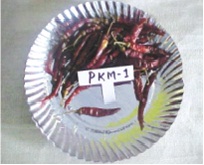 |
PMK 1 :
It is a hybrid derivative of the cross CO2 X Ramanad mundu.Suitable for rainfed cultivation. Yields about 2.3 tonnes/ha of dry pods under rainfed condition.Capsicin content is 0.36 percent
|  |
PLR 1:
It is a pureline selection from Kandangadu type. Yields about 18.40 tonnes/ha of green chilli in a crop duration of 210 days .Fruits are pendulous, medium in size with bulging base and blunt tip, glossy appearance.Suitable for pickling using buttermilk.
| |
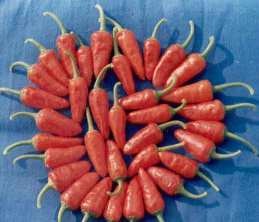 | PMK 1:
It is a hybrid derivative of the cross CO2 X Ramanad mundu.Suitable for rainfed cultivation. Yields about 2.3 tonnes/ha of dry pods under rainfed condition.Capsicin content is 0.36 percent
| |||
Soil
Well drained loamy soils rich in organic matter with pH range 6.5-7.5.
Well drained loamy soils rich in organic matter with pH range 6.5-7.5.
Season of sowing
1. January - February
2. June - July
3. September- October
1. January - February
2. June - July
3. September- October
Seed rate
Varieties: 1.0 kg / ha.
Hybrids: 200 - 250 g / ha.
Nursery area: 100 sq.m / ha.
Varieties: 1.0 kg / ha.
Hybrids: 200 - 250 g / ha.
Nursery area: 100 sq.m / ha.
Seed treatment
Treat the seeds with Trichoderma viride @ 4 g / kg or Pseudomonas fluorescens @ 10 g/ kg and sow in lines spaced at 10 cm in raised nursery beds and cover with sand. Watering with rose can has to be done daily. Drench the nursery with Copper oxychloride @ 2.5 g/l of water at 15 days interval against damping off disease. Apply Carbofuran 3 G at 10 g/sq.m. at sowing.
Treat the seeds with Trichoderma viride @ 4 g / kg or Pseudomonas fluorescens @ 10 g/ kg and sow in lines spaced at 10 cm in raised nursery beds and cover with sand. Watering with rose can has to be done daily. Drench the nursery with Copper oxychloride @ 2.5 g/l of water at 15 days interval against damping off disease. Apply Carbofuran 3 G at 10 g/sq.m. at sowing.
Protected nursery
- Prepare the nursery area of 3 cents with slanting slope of 2 % for the seedling production to cover 1 ha.
- Cover the nursery area with 50 % shade net and cover the sides using 40 / 50 mesh insect proof nylon net.
- Form raised beds of 1 m width and convenient length and place HDPV pipes at 2m interval for further protection with polythene sheets during rainy months.
- Mix sterilized cocopeat @ 300 kg with 5 kg neem cake along with Azospirillum and phosphobacteria each @ 1 kg. Approximately 1.2 kg of cocopeat is required for filling one protay. 300 protrays (98 cells) are required for the production of 29,000 seedlings, which are required for one hectare adopting a spacing of 90 x 60 x 45 cm in a paired row system.
- Sow the treated seed in protrays @ 1 seed per cell.
- Cover the seed with cocopeat and keep the trays one above the other and cover with a polythene sheet till germination starts.
- After 6 days place the protrays with germinated seedlings individually on the raised beds inside the shade net.
- Water with rose can everyday upto seed germination. Drench with 19:19:19 @ 0.5% (5g/l) at 18 days after sowing.
Field preparation
Thoroughly prepare the field with the addition of FYM @ 25 t/ ha and form ridges and furrows at a spacing of 60 cm. Apply 2 kg/ha of Azospirillum and 2 kg / ha of Phosphobacteria by mixing with 20 kg of FYM. Irrigate the furrows and transplant 40-45 days old seedlings, with the ball of earth on the ridges.
Thoroughly prepare the field with the addition of FYM @ 25 t/ ha and form ridges and furrows at a spacing of 60 cm. Apply 2 kg/ha of Azospirillum and 2 kg / ha of Phosphobacteria by mixing with 20 kg of FYM. Irrigate the furrows and transplant 40-45 days old seedlings, with the ball of earth on the ridges.
Spacing
Varieties : 60 x 45 cm
Hybrids : 75 x 60 cm
Varieties : 60 x 45 cm
Hybrids : 75 x 60 cm
Weed control
Apply Pendimethalin 1.0 kg a.i. / ha or Fluchloralin 1.0 kg a.i. / ha as pre-emergece herbicide followed by hand weeding once 30 days after planting.
Apply Pendimethalin 1.0 kg a.i. / ha or Fluchloralin 1.0 kg a.i. / ha as pre-emergece herbicide followed by hand weeding once 30 days after planting.
Irrigation
Irrigate is done at weekly intervals.
Irrigate is done at weekly intervals.
Layout and planting for drip irrigation and fertigation
- Apply FYM @ 25 t / ha as basal before last ploughing.
- Apply 2 kg / ha of Azospirillum and 2 kg/ha Phosphobacteria by mixing with 20 kg of FYM.
- Apply 75 % total recommended dose of superphosphate i.e. 375 kg / ha as basal.
- Install the drip irrigation with main and sub main pipes and place lateral tubes at an interval of 1.5 m.
- Place the drippers in lateral tubes at an interval of 60 cm and 50 cm spacing with 4 LPH and 3.5 LPH capacities respectively.
- Form raised beds of 120 cm width at an interval of 30 cm and place the laterals at the centre of the each bed.
- Before planting wet the beds using drip system for 8-12 hrs.
- Planting to be done at a spacing of 90 x 60 x 45 cm in the paired row system, using ropes marked at 60 cm spacing.
- Spray Pendimethalin 1.0 kg a.i. / ha or Fluchloralin 1.0 kg a.i / ha as pre-emergence herbicide at 3rd day after planting.
- Gap filling to be done at 7th day after transplanting.
Manuring
Varieties
Basal dose : FYM 25 t/ha, NPK 30:60:30 kg/ ha.
Potassium as K2SO4 for quality improvement. Application of potassium in the form of potassium sulphate will increase quality of chilli.
Top dressing : 30 kg N/ha in equal splits on 30, 60 and 90 days after planting.
Varieties
Basal dose : FYM 25 t/ha, NPK 30:60:30 kg/ ha.
Potassium as K2SO4 for quality improvement. Application of potassium in the form of potassium sulphate will increase quality of chilli.
Top dressing : 30 kg N/ha in equal splits on 30, 60 and 90 days after planting.
Hybrids
Basal dose : FYM 30 t / ha, NPK 30:80:80 kg / ha.
Top dressing : 30 kg N / ha in equal splits on 30, 60 and 90 days after planting.
Basal dose : FYM 30 t / ha, NPK 30:80:80 kg / ha.
Top dressing : 30 kg N / ha in equal splits on 30, 60 and 90 days after planting.
Fertigation schedule
CHILLI F1 HYBRID
Recommended Dose: 120:80:80 kg / ha
CHILLI F1 HYBRID
Recommended Dose: 120:80:80 kg / ha
| Stage | Crop stage | Duration in days | Fertilizer grade | Total Fertilizer (kg/ha) | Nutrient supplied | % requirement | ||||
| N | P | K | N | P | K | |||||
| 1 | Transplanting to plant establishment stage | 10 | 19:19:19 MN 13:0:45 Urea | 21.05 8.88 14.86 | 4.00 1.15 6.83 | 4.00 - - | 4.00 3.98 - | 10.00 | 5.00 | 10.00 |
| Subtotal | 11.98 | 4.00 | 7.98 | |||||||
| 2 | Flower initiation to flowering | 30 | 12:61:0 13:0:45 Urea | 13.11 71.04 80.72 | 1.57 9.24 37.13 | 8.00 - - | - 31.97 - | 30.00 | 10.00 | 20.00 |
| Subtotal | 47.94 | 8.00 | 31.97 | |||||||
| 3 | Flowering set to fruit picking | 30 | 19:19:19 13.0:45 Urea | 21.05 44.40 56.91 | 4.00 5.77 26.18 | 4.00 - - | 4.00 19.98 | 30.00 | 5.00 | 20.00 |
| Subtotal | 35.95 | 4.00 | 23.98 | |||||||
| 4 | Alternate day from picking | 8 | 12:61:0 13:0:45 Urea | 6.52 35.52 40.38 | 0.75 4.62 18.57 | 3.81 - - | - 15.98 - | 30.00 | 5.00 | 50.00 |
| Subtotal | 23.94 | 3.81 | 15.98 | |||||||
| 119.81 (or) 120.00 | 19.81 (or) 20.00 | 79.91 (or) 80.00 | 100.00 | 25.00 | 100.00 | |||||
75% RD of Phosporous applied as superphosphate = 375 kg / ha
1. 19:19:19 = 42 kg/ha
2. 13:0:45 = 160 kg/ha
3. 12:61:0 = 20 kg/ha
4. Urea = 193 kg/ha
1. 19:19:19 = 42 kg/ha
2. 13:0:45 = 160 kg/ha
3. 12:61:0 = 20 kg/ha
4. Urea = 193 kg/ha
Effect of Endo root soluble and Mycorrhizae on Chilli
Apply 250g of Endo Roots Soluble in two splits doses at 15 DAT and 45 DAT along with 100 % N and K and 50% P for higher yield and saving of Phosphorous.
Apply 250g of Mycorrhiza in two splits at transplanting and 30 DAT along with 100% N and K and 50% P for higher yield and saving of Phosphorous.
Apply 250g of Endo Roots Soluble in two splits doses at 15 DAT and 45 DAT along with 100 % N and K and 50% P for higher yield and saving of Phosphorous.
Apply 250g of Mycorrhiza in two splits at transplanting and 30 DAT along with 100% N and K and 50% P for higher yield and saving of Phosphorous.
Growth regulators
Spray Triacontanol @ 1.25 ml/l on 20, 40, 60 and 80th day of planting. Spray NAA 10 ppm (10 mg/l of water) on 60 and 90 days after planting to increase fruit set.
Spray Triacontanol @ 1.25 ml/l on 20, 40, 60 and 80th day of planting. Spray NAA 10 ppm (10 mg/l of water) on 60 and 90 days after planting to increase fruit set.
Micronutrient spray
Foliar spray of Zn SO4 @ 0.5 per cent thrice at 10 days interval from 40 days after planting.
Spray 19:19:19 + Mn @ 1 % at 60 days after planting.
Foliar spray of Zn SO4 @ 0.5 per cent thrice at 10 days interval from 40 days after planting.
Spray 19:19:19 + Mn @ 1 % at 60 days after planting.
Weed control
Spray Fluchloralin @ 1 lit a.i/ha or Pendimethalin @ 1 kg a.i/ ha. or Oxyflourfen @ 0.15 kg a.i./ha as pre-emergence herbicide and may be combined with hand weeding once and earthing up 45 days after planting. Raise intercrop of onion in paired row system to get additional income.
Spray Fluchloralin @ 1 lit a.i/ha or Pendimethalin @ 1 kg a.i/ ha. or Oxyflourfen @ 0.15 kg a.i./ha as pre-emergence herbicide and may be combined with hand weeding once and earthing up 45 days after planting. Raise intercrop of onion in paired row system to get additional income.
Intercropping
The intercrops like onion and coriander can be grown for getting additional income. It can also help to control the weed population.
The intercrops like onion and coriander can be grown for getting additional income. It can also help to control the weed population.
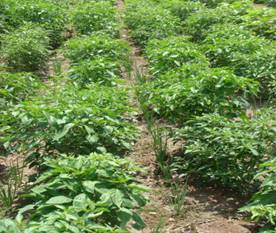 |
Intercropping with onion
|
Plant protection
Pests
Fruit borer
Integrated pest management of fruit borer:
Pests
Fruit borer
Integrated pest management of fruit borer:
- Set up pheromone traps for Helicoverpa armigera or Spodoptera litura at 12 Nos./ha.
- Collection and destruction of damaged fruits and grown up caterpillars.
- Spray Bacillus thuringiensis at 2 g/lit.
- Provide poison bait with carbaryl 1.25 kg, rice bran 12.5 kg, jaggery 1.25 kg and water 7.5 lit/ha or spray any one of the following insecticide
Insecticide
|
Dose
|
Emamectin benzoate 5 % SG
|
4 g/10 lit.
|
| Fipronil 5 % SC | 2.0 ml /lit. |
Flubendiamide 20 WDG
|
6.0 g /10 lit.
|
| Flubendiamide 480 SC | 2.5 ml /lit |
Indoxacarb 14.5 % SC
|
6.5 ml/10 lit.
|
Novaluron 10 % EC
|
7.5 ml/10 lit.
|
Spinosad 45 % SC
|
3.2 ml/10 lit.
|
Thiodicarb 75 % WP
|
2.0 g/lit.
|
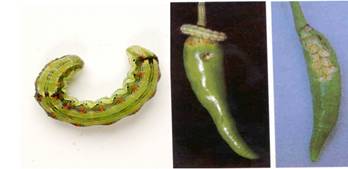 |
Helicoverpa armigera infested pods
|
 |
Spodoptera litura infestaion
|
Thrips
- Grow Agathi as Intercrop
- Treat seeds with imidacloprid 70% WS @ 12 g /kg of seed
- Apply carbofuran 3% G @ 33 kg /ha or phorate 10 % G @ 10 kg/ha or spray any one of the following insecticide
Insecticide
|
Dose
|
Imidacloprid 17.8 % SL
|
3.0 ml/10 lit.
|
Dimethoate 30 % EC
|
1.0 ml/lit.
|
Emamectin benzoate 5 % SG
|
4 g/10 lit.
|
Ethion 50 % EC
|
2.0 ml/lit.
|
Fipronil 5 % SC
|
1.5 ml/lit.
|
Oxydemeton –Methyl 25 % EC
|
1.0 ml/lit.
|
Phosalone 35 % EC
|
2.0 ml/lit.
|
Spinosad 45 % SC
|
3.2 ml/10 lit.
|
Thiacloprid 21.7 % SC
|
6.0 ml/10 lit.
|
Aphids
Treat seeds with imidacloprid 70% WS @12 g /kg of seed. Apply phorate 10 % G @ 10 kg/ha or spray any one of the following insecticide
Insecticide
|
Dose
|
Carbosulfan 25 % EC
|
1.0 ml/lit.
|
Fipronil 5 % SC
|
1.0 ml/lit.
|
Imidacloprid 17.8 % SL
|
3.5 ml/10 lit.
|
Oxydemeton –Methyl 25% EC
|
1.6 ml/lit.
|
Phosalone 35 % EC
|
2.0 ml/lit.
|
Quinalphos 25 % Gel
|
1.0 ml/lit.
|
Quinalphos 25 % EC
|
1.0 ml/lit.
|
Yellow Muranai mite
Apply phorate 10 % G @ 10 kg/ha or spray any one of the following insecticide
Insecticide
|
Dose
|
Buprofezin 25 % SC
|
8.0 ml/10 lit.
|
Diafenthiuron 50 % WP
|
8.0 g/10 lit.
|
Dimethoate 30 % EC
|
1.0 ml/lit.
|
Ethion 50 % EC
|
2.0 ml/lit.
|
Fenazaquin 10 % EC
|
2.0 ml/lit.
|
Fenpyroximate 5 % EC
|
1.0 ml/lit.
|
Hexythiazox 5.45 % EC
|
8.0 ml/10 lit.
|
Milbemectin 1 % EC
|
6.5 ml/10 lit.
|
Oxydemeton –Methyl 25 % EC
|
2.0 ml/lit.
|
Phosalone 35 % EC
|
1.3 ml/lit.
|
Propargite 57 % EC
|
2.5 ml/lit.
|
Quinalphos 25 % EC
|
1.5 ml/lit.
|
Spiromesifen 22.9 % SC
|
5.0 ml/10 lit.
|
Root knot nematode
Apply TNAU formulation of VAM (containing 1 spore/g) to control root knot nematode in nursery.
Apply TNAU formulation of VAM (containing 1 spore/g) to control root knot nematode in nursery.
Diseases
Damping off
Treat the seeds with Trichoderma viride 4 g/kg or Pseudomonas fluorescens 10 g/kg of seed 24 hours before sowing. Apply Pseudomonas fluorescens as soil application @ 2.5 kg/ha mixed with 50 kg of FYM. Water stagnation should be avoided and drench with Copper oxychloride at 2.5 g/lit at 4 lit/sq.m
Damping off
Treat the seeds with Trichoderma viride 4 g/kg or Pseudomonas fluorescens 10 g/kg of seed 24 hours before sowing. Apply Pseudomonas fluorescens as soil application @ 2.5 kg/ha mixed with 50 kg of FYM. Water stagnation should be avoided and drench with Copper oxychloride at 2.5 g/lit at 4 lit/sq.m
Leaf spot
Leaf spot can be controlled by spraying Mancozeb 2 g/lit or Copper oxychloride 2.5 g/lit.
Leaf spot can be controlled by spraying Mancozeb 2 g/lit or Copper oxychloride 2.5 g/lit.
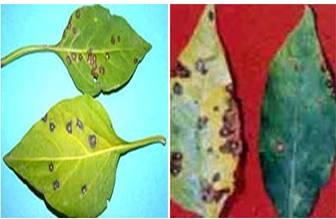 |
Cercospora leafspot in chilli
|
Powdery mildew
Powdery mildew can be spraying Wettable sulphur 3 g/lit or Carbendazim 1 g/lit. Totally 3 sprays are required at 15 days interval from the first appearance of symptom.
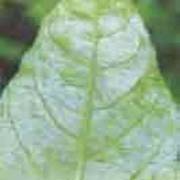 |
Powdery mildew in chilli
|
Die-back and fruit rot
Spray Mancozeb 2 g/lit or Copper oxychloride 2.5 g/lit. thrice at 15 days interval starting from noticing the die-back symptoms.
Spray Mancozeb 2 g/lit or Copper oxychloride 2.5 g/lit. thrice at 15 days interval starting from noticing the die-back symptoms.
Anthracnose
Use of disease-free seeds
Treat the seeds with T. viride 4 g/kg or P. fluorescens 10 g / kg of seed 24 hours before sowing
Spray Mancozeb 2 g/lit or Copper oxychloride 2.5 g/lit thrice at 15 days interval starting from noticing the die-back symptoms
Use of disease-free seeds
Treat the seeds with T. viride 4 g/kg or P. fluorescens 10 g / kg of seed 24 hours before sowing
Spray Mancozeb 2 g/lit or Copper oxychloride 2.5 g/lit thrice at 15 days interval starting from noticing the die-back symptoms
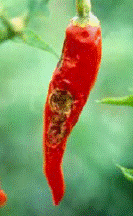 |
Anthracnose in chilli
|
Chilli mosaic
Raise 2 rows of maize or sorghum for every 5 rows of chilli crop against wind direction. Recommendations given for aphids may be adopted for controlling the vector.
Raise 2 rows of maize or sorghum for every 5 rows of chilli crop against wind direction. Recommendations given for aphids may be adopted for controlling the vector.
 |
Chilli mosaic
|
Harvest
Harvesting can be done 75 days after transplanting. First two picking yield green chilli and subsequently yield red ripe fruits.
Harvesting can be done 75 days after transplanting. First two picking yield green chilli and subsequently yield red ripe fruits.
Yield
Varieties : 2 - 3 t/ha of dry pods or 10 - 15 t/ha of green chillies.
Hybrids : 25 t / ha of green chillies.
Varieties : 2 - 3 t/ha of dry pods or 10 - 15 t/ha of green chillies.
Hybrids : 25 t / ha of green chillies.
Market information
Crop Growing districts |
Ramanathapuram (samba), Thoothukudi (gundu), Sivagangai (samba), Virudhunagar (samba), Tirunelveli (samba)
|
Major markets in Tamil Nadu
|
Virudhunagar, Chennai, Ramanad, Paramkudi,
Thoothukudi |
Grade Specification
|
i) Dry Chilli
Well dried -12 % moisture Big size Bright red colour without white chillies Uniform size Length - 1.5-2 inches ii) Green Chilli Pungency |
No comments:
Post a Comment